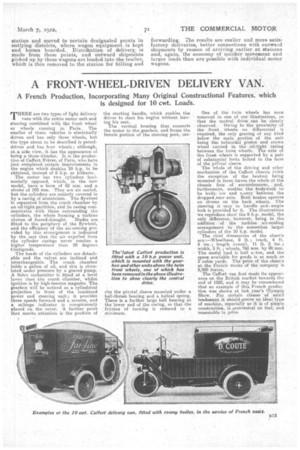A FRONT-WHEEL-DRIVEN DELIVERY VAN.
Page 11

If you've noticed an error in this article please click here to report it so we can fix it.
A French Production, Incorporating Many Original Constructional Features, which is designed for 10 cwt. Loads.
THERE are two types of light delivery I vans with the entire motor unit and steering combined with the front wheel or wheels running in Paris. The smaller of these vehicles is electrically driven and has only three wheels, but the type about to be described is petroldriven and has four wheels ; although, at a side view, it has the appearance of being a three-wheeler. It is the production of Caffort Freres., of Paris, who have just completed certain improvements in the engine which enables 10 h.p. to be obtained, instead of 8 ELI). as hitherto. The motor has two cylinders horizontally opposed, which, in the new model, have a bore of 82 mm. and a stroke of 100 mm. They are .air cooled, but the cylinders are entirely covered in by a casing of aluminium. The flywheel Is separated from the crank chamber by an oil-tight partition, and its casing communicates with those surrounding the cylinders, the whole forming a turbine system of forced-draught. Blades are fitted to the periphery of the flywheel, and the efficiency of the air-cooling provided by this arranement is indicated by the 'act that the air expelled from the cylinder casings never reaches a higher temperature than 98 degrees Centigrade.
The heads of the cylinders are detachable and the valves are inclined and interchangeable. The crank chamber holds a. gallon of oil, and this is circulated under pressure by a geared pump. A So1ex carburetter is fitted at a level lower than the crank chamber, whilst ignition is by high-tension magneto. The gearbox will be noticed as a cylindrical projection in front of the combined power and steering unit; it provides three speeds forward and a reverse, and a mileage indicator is conspicuously placed on the cover. A further point that merits attention is the position of the starting handle, which enables the driver to start his engine without leaving his seat. The vertical housing that connects the motor to the gearbox, and forms the female portion of the steering post, car rise the pivotal sleeve mounted under a ball-thrust bearing and a helical spring. There is a further large ball bearing at the lower end of the casing, so that the friction of turning is reduced to a minimum. One of the twin wheels has been removed in one of our illustrations, so that the central drive can be clearly ubserved. Owing to the proximity of the front wheels no differential is required, the only gearing of any kind below the main portion of the unit being the helicoichil pinion and crown wheel carried in the oil-tight casing between the front wheels. lhe axle of the front wheels is supported by a pair of substantial forks bolted to the base of the pivotal sleeve. The whole of the driving and other mechanism of the Caffort chassis (with the exception of the brakes) being mounted in front leaves the whole of the chassis free of ennumbrances, and, furthermore, enables the bodywork to be built: low and roomy between the dropped ,rear axle. Both brakes operate on drums on the back wheels. The steering is easy to handle ands ample lock is provided by it. The illustrations we reproduce show the 8 h.p. model, the only difference, however, being in the addition . of the turbine air-cobling arrangement to the somewhat larger cylinders of the 10 h.p. model.
The chief dimensions of the chassis are :—Wheelbase 8 ft.; track, 4 ft. 8 ins.; length overall, II. ft. 2 ins. ; width, 5 ft. ? • wheels 769 mm. by 90 mm. The useful load is ?half a;ton, and the space available for goods is as much as 3 cubic yards. The price of the chass's at.; the French works of the company is 9,500 francs, The Caffort van first made its appearance on the British market towards the end of 1920, and it may be remembered that an example of this. French produs, tion was shown at last year's Olympia :Show. For certain classes of small tradesmen it shoeld Trove an ideal type of machine, especially as it is of simple constrUctiosi, is „economical on fuel, and reasonable in price.






























